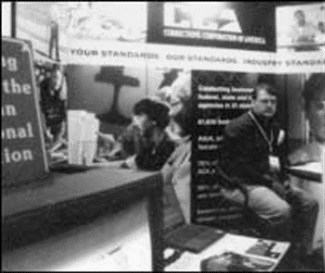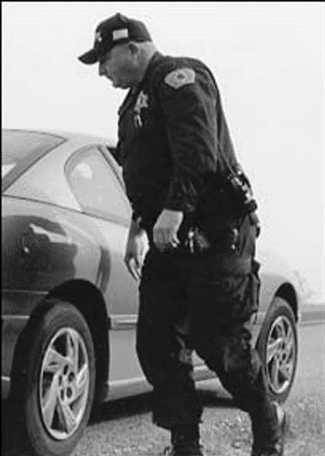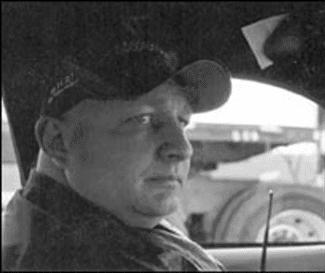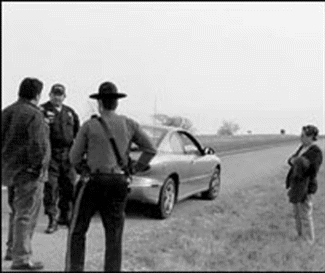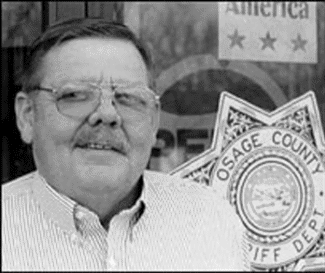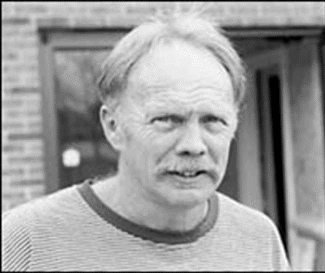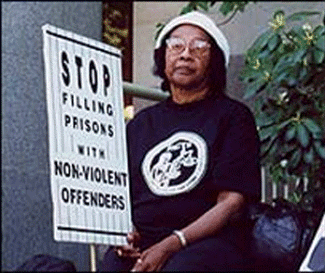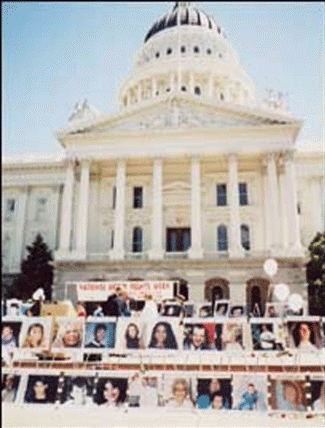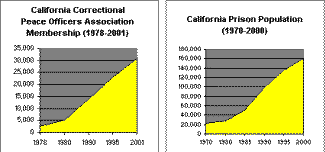by John Biewen
April 2002
NOTICE: THIS WORK MAY BE PROTECTED BY COPYRIGHT
YOU ARE REQUIRED TO READ THE COPYRIGHT NOTICE AT THIS LINK BEFORE YOU READ THE FOLLOWING WORK, THAT IS AVAILABLE SOLELY FOR PRIVATE STUDY, SCHOLARSHIP OR RESEARCH PURSUANT TO 17 U.S.C. SECTION 107 AND 108. IN THE EVENT THAT THE LIBRARY DETERMINES THAT UNLAWFUL COPYING OF THIS WORK HAS OCCURRED, THE LIBRARY HAS THE RIGHT TO BLOCK THE I.P. ADDRESS AT WHICH THE UNLAWFUL COPYING APPEARED TO HAVE OCCURRED. THANK YOU FOR RESPECTING THE RIGHTS OF COPYRIGHT OWNERS.
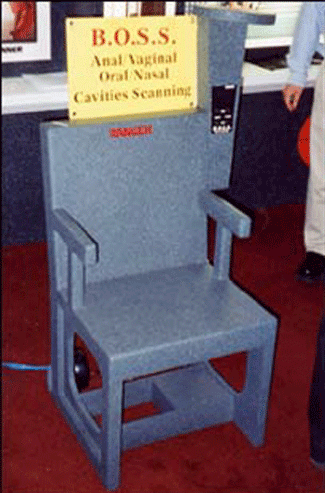
The Body Orifice Security Scanner (B.O.S.S) detects metal contraband hidden inside the body. You can get a B.O.S.S. chair for $5,000. Photo: John Biewen
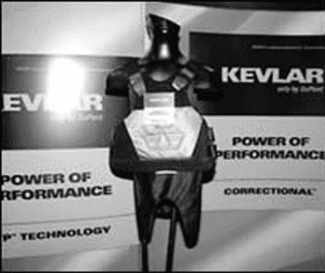
Dupont shows off a new lightweight, Kevlar protective vest just for prison guards. Photo: Steve Schapiro
Over the past two decades, America's prison population doubled, then doubled again, before finally leveling off at about two million inmates. One result: a $50-billion corrections industry. That's bigger than tobacco. The crackdown on crime has enriched corporations that build prisons or sell products to them, prison guard unions, and police departments that use budget-fattening incentives to pursue drug criminals. In this special report, American RadioWorks correspondent John Biewen explores how some groups with vested interests work to influence public policy— helping to keep more people locked up longer.
Prison Industry a Revenue-Generating Opportunity
The annual trade show sponsored by the American Correctional Association is like other big trade shows: a sprawling bazaar of colorful display booths. This one fills a huge hall at the Pennsylvania Convention Center in Philadelphia. It brings together shoppers — mostly prison administrators — and hundreds of vendors hawking their wares.
You can find plenty of companies selling the basics, of course: prison design and construction; fence and razor wire; uniforms as well as RIT dye to color-code those uniforms and a system for stamping them with numbers and bar codes; handcuffs; surveillance equipment; janitor services; steel doors and powerful locks and the electronic control rooms from which to operate them.
The major phone companies are here — Sprint, Verizon, AT&T and the Bells and former Bells — vying to provide collect-call service to inmates' families. Dupont shows off a new lightweight, Kevlar protective vest just for prison guards. It won't stop a bullet but it will protect against inmates attempting to "stab and slash" the officer, explains Dupont's Gary Burnett. Of the 450,000 guards in the nation's prisons and jails, "only about fifteen-percent of them are now protected, so the goal is to get protection on as many as possible," Burnett says.
Then there's the eye-catching B.O.S.S. chair. With its wires and straight back and gray finish it looks electric. But it's not what you think. It's the Body Orifice Security Scanner, a device designed to detect metal contraband hidden inside the body.
"We're looking for handcuffs, keys, razor blades, small shanks, etcetera. Basically the person sits down in the chair; if they have any metal contraband hidden in the vaginal or anal cavity," the chair's display panel lights up and beeps, explains David Turner of Ranger Security Technologies.
You can get a B.O.S.S. chair for $5,000.
On its Web site, the American Correctional Association points to the $50 billion spent each year to run the nation's prisons and jails. And it warns companies, "Don't miss out on this prime revenue-generating opportunity."
Is the Prison Industry Self-Serving?
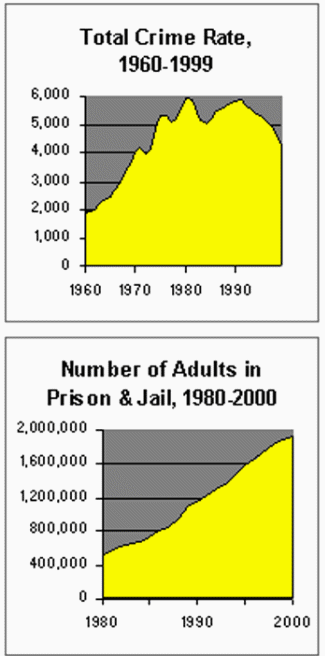
Crime soared in the 1970s and '80s but dropped off in the '90s. However since 1980 the prison and jail population has steadily grown. Source: Bureau of Justice Statistics
Think of it. Two million prisoners eat six million meals a day. Here to help meet that need is Jim Carroll of Canteen Correctional Services. "We provide food services and commissary services to correctional facilities nationwide."
Inmates get sick. Another corporation, the St. Louis-based Correctional Medical Services, is the leading provider of "comprehensive medical care in jails and prisons on a contract basis," explains company representative Jim Chaney.
Prisoners exercise and kill time in the game room. "We sell a lot of sporting games, board games, puzzles, table games to prison facilities," says Brian Wexler, Vice President of Sales and Marketing with Quality Table Games.
Some people point to all this money being made on prisons and wonder: Is the industry serving the needs of inmates, or is it the other way around?
Outside the convention center in Philadelphia, a few hundred people block traffic for a peaceful march through Center City. These protesters say a powerful web of private and public interests — the prison-industrial complex — perpetuates the war on crime for money.
"No more prisons! No more prisons!" they chant. A young woman shouts through a scratchy megaphone: "We are no longer asking. We are demanding! No more making money off of the flesh of other human beings!"
Some conventioneers with the Correctional Association seem bemused at the notion that they're causing people to get locked up.
"I think it's Halloween in Philadelphia, man," says conventioneer Ray Zaroufie as he waits to cross the street outside the convention center and watches chanting protesters dressed in striped inmate costumes.
Zaroufie works for a Tennessee-based company that supplies prison commissaries. "Do prisoners got to eat?" he asks. "Do they got to shave? I mean, somebody's got to sell that to the state to put in those jails and the prisons, right?"
Zaroufie has a point. Just because people make a profit from prisons, that doesn't mean there's a corrections lobby that works to drive up the inmate population. Certainly other forces have helped to do that. Crime soared in the 1970s and '80s. The news media devoted headlines and the tops of newscasts to the crack epidemic and gang warfare. Many Americans were alarmed. Politicians from both major parties seized the issue and held on tight. For two decades, a political consensus prevailed: the nation needed tougher sentences, more police, more prisons.
Sure, when it snowed prison-related contracts, businesses flocked to grab them. But do corporations also try to boost demand for their services? To some activists concerned about a "prison-industrial complex," the American Legislative Exchange Council presents a striking case in point.
Corporate-Sponsored Legislation

Turner Construction Company's booth at the annual trade show sponsored by the American Correctional Association. Turner is a construction giant and the nation's number one builder of prisons. Photo: Steve Schapiro
The American Legislative Exchange Council — ALEC for short — is not well known to the general public and doesn't try to be. But the organization, founded in the early 1970s, boasts of helping to pass hundreds of state laws every year: From tax cuts to loosened environmental regulations to longer prison sentences.
"As you know, ALEC plays a vital if understated role in shaping our national agenda," Tennessee State Representative Steve McDaniel told a luncheon audience of a thousand at ALEC's annual meeting last summer at the Marriott Marquis in New York City's Times Square. "We are the unsung heroes of American public policy."
More than a third of the nation's state lawmakers — 2400 of them — are members of ALEC. Most are Republicans and conservative Democrats. ALEC says its mission is to promote free markets, small government, states' rights, and privatization. Members gather at ALEC meetings to swap ideas and form "model legislation." Legislators then take those "model" bills home and try to make them state law.
In a luncheon speech to the group, former Wisconsin Governor Tommy Thompson—now the Bush administration's health and human services secretary—fondly remembers his days as a state rep and an early ALEC member in the 1970s.
"Myself, I always loved going to these meetings because I always found new ideas. Then I'd take them back to Wisconsin, disguise them a little bit, and declare that 'It's mine.'"
In forming and spreading its ideas, ALEC gets help from corporate leaders. More than a hundred companies co-sponsor ALEC conferences — including Turner, a construction giant and the nation's number one builder of prisons; and Wackenhut Corrections, a private prison corporation.
Another 200 companies and interest groups join ALEC as "private-sector members." They pay dues for the privilege of helping to write ALEC's model bills.
The result is corporate-sponsored legislation, says Edwin Bender of the National Institute on Money in State Politics. "Bayer Corporation or Bell South or GTE or Merck pharmaceutical company sitting at a table with elected representatives, actually hammering out a piece of legislation — behind closed doors, I mean, this isn't open to the public. And that then becomes the basis on which representatives are going to their state legislatures and debating issues."
Tough-on-Crime Measures Increase Prison Population
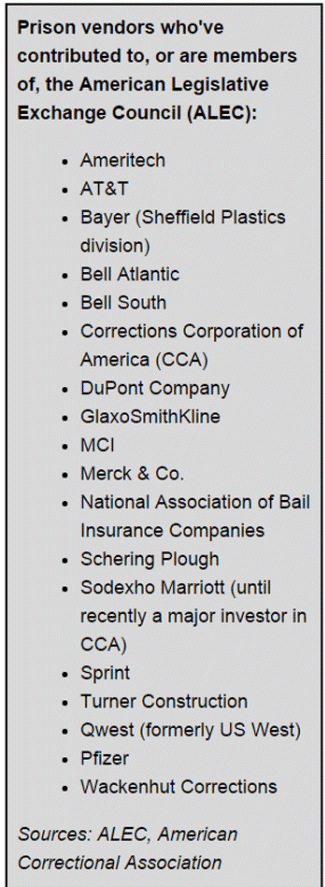
ALEC's corporate members include at least a dozen companies that do prison business. Like Dupont; the drug companies, Merck and Glaxo Smith-Klein; and the telephone companies that compete for lucrative prison contracts. And Corrections Corporation of America (CCA). It dominates the private prison business — building and running prisons and renting cells to governments. At last count the company housed 55,000 inmates in 65 facilities in twenty-one states and Puerto Rico, says CCA Vice President Louise Green.
Neither CCA nor the American Legislative Exchange Council will say how much CCA pays for its ALEC membership. The latter group's corporate memberships go for $5,000 to $50,000 a year. Green says belonging to ALEC gives the corrections corporation a chance to explain the benefits of privately-run prisons to state lawmakers — "that if those states and counties have considerable overcrowding in their jails and prisons that partnering with a private corrections company can realize cost savings to their taxpayers and we can offer effective programming for their inmates."
But CCA does more than chat up lawmakers at ALEC meetings. On top of its membership dues and contributions to help pay the bills for ALEC meetings, the prison company pays two thousand dollars a year for a seat on ALEC's Criminal Justice Task Force. That panel writes the group's "model" bills on crime and punishment. Until recently, a CCA official even co-chaired the task force. For years, ALEC's criminal justice committee has promoted state laws letting private prison companies operate. And at least since the early 1990s, it has pushed a tough-on-crime agenda.
ALEC officials say proudly that lawmakers on the group's crime task force led the drive for more incarceration in the states — "and really took the forefront in promoting those ideals and then taking them into their states and talking to their colleagues and getting their colleagues to understand that if, you know, we want to reduce crime we have to get these guys off the streets," says ALEC staffer and Criminal Justice Task Force director Andrew LeFevre.
Among ALEC's model bills: mandatory minimum sentences; Three Strikes laws, giving repeat offenders 25 years to life in prison; and "truth-in-sentencing," which requires inmates to serve most or all of their time without a chance for parole. ALEC didn't invent any of these ideas but has played a pivotal role in making them law in the states, says Bender of the National Institute on Money in State Politics.
"By ALEC's own admission in its 1995 Model Legislation Scorecard, they were very successful. They had introduced 199 bills [that year]. The Truth-in-Sentencing Act had become law in 25 states, so that right there is fairly significant."
By the late 1990s, about forty states had passed versions of truth-in sentencing similar to ALEC's model bill. Because of truth-in-sentencing and other tough sentencing measures, state prison populations grew by half a million inmates in the 1990s even while crime rates fell dramatically.
The result: more demand for private prison companies like CCA.
Truth-in-sentencing in Wisconsin
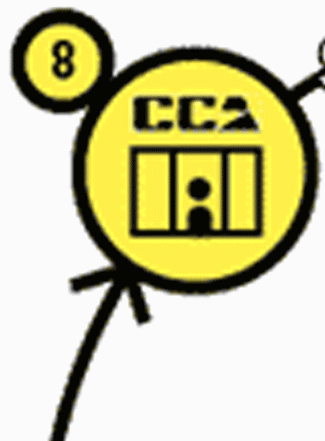
Case Study: Wisconsin
See how the Corrections Corporation of America benefits from its involvement with the American Legislative Council.
In Wisconsin, a group of lawmakers led passage of truth-in-sentencing in 1998.
"Many of us, myself included, were part of ALEC," says the bill's author, Republican state representative Scott Walker.
"Clearly ALEC had proposed model legislation," Walker recalls. "And probably more important than just the model legislation, [ALEC] had actually put together reports and such that showed the benefits of truth-in-sentencing and showed the successes in other states. And those sorts of statistics were very helpful to us when we pushed it through, when we passed the final legislation."
But a former head of Wisconsin's prison system, Walter Dickey — now a University of Wisconsin Law Professor — says he finds it "shocking" that lawmakers would write sentencing policy with help from ALEC, a group that gets funding and, supposedly, expertise, from a private prison corporation.
"I don't know that they know anything about sentencing," Dickey says. "They know how to build prisons, presumably, since that's the business they're in. They don't know anything about probation and parole. They don't know about the development of alternatives. They don't know about how public safety might be created and defended in communities in this state and other states."
The Wisconsin Department of Corrections says the truth-in-sentencing law will add to the state's prison population in the years to come. A recent analysis by the state estimated that the 990 inmates imprisoned just in the first 21 months after the law took effect would spend 18,384 additional months in jail, costing taxpayers an extra $41 million.
That's money in the bank for Corrections Corporation of America, the company that sits on the committee that wrote ALEC's truth-in-sentencing bill. Wisconsin is a CCA customer. Its prisons are overcrowded, so the state houses more than three thousand inmates at CCA facilities in Minnesota, Oklahoma, and Tennessee. The price tag: more than $50 million a year.
Representative Walker says he understood that CCA and some other ALEC contributors stood to profit from the truth-in-sentencing bill. He insists he took that into account before deciding to sponsor the measure.
"Oftentimes that's your greatest challenge, as a legislator, is trying to weed through what everybody's hidden agenda is, and figure out who's giving you credible information and in many cases playing one interest off of another to try and figure out what the truth is. More information to me is better," Walker says.
Still, Walker says that he and his fellow ALEC members relied on an ALEC report that credited Virginia's truth-in-sentencing law with a five-year drop in that state's crime rate. The trouble is, crime dropped in all states in the 1990s whether or not they passed laws like truth-in-sentencing. Experts struggle to understand why, but they generally give sentencing policies just a small fraction of the credit, says criminologist Alfred Blumstein of Carnegie-Mellon University and editor of the recent book, The Crime Drop in America. Other likely factors include economics, changing drug markets, demographics, and social change — that is, more young people catching on that drug use and trafficking are self-destructive.
Simple cause and effect equations like the one produced by ALEC — crediting truth-in-sentencing with a given state's dropping crime rate — are frequently used by advocates, not scientists, Blumstein says. "Whenever somebody with an interest in some aspect of the crime-fighting business is asked why crime has gone down or gone up, somehow they always are able to point to the issue they're most interested in as the cause of it."
The Place of Profit in Criminal Justice Policy
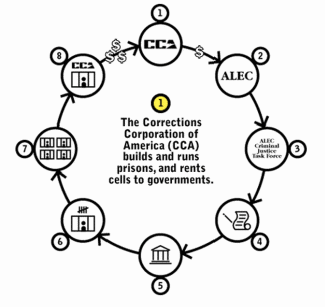
The Corrections Corporation of America has a prominent place at the American Correctional Association trade show. Company officials say CCA does not take an active role in writing or promoting ALEC's model sentencing bills. Photo: Steve Schapiro
The Corrections Corporation of America booth, with its black and yellow logo, has a prominent place at the American Correctional Association trade show. CCA's Vice President of Customer Relations, James Ball, says CCA does not take an active role in writing or promoting ALEC's model sentencing bills.
"You don't see CCA advocating for longer sentences; that's not true. If government, through its elected representatives, identified that, well, we are going to need to provide for public safety by incarcerating individuals — that is not a vendor-driven issue," Ball says.
Asked if giving money and time to the American Legislative Exchange Council doesn't constitute support for tough sentencing policies, Ball says ALEC is just a research group and doesn't drive public policy. In fact, ALEC's stated mission is to drive public policy.
The former Wisconsin Corrections Administrator, Walter Dickey, says he paid close attention to the debate over truth-in-sentencing in Madison. "There was never any mention that ALEC or anybody else had any involvement" in the crafting of the bill, Dickey says.
The public debate over criminal justice policy — how to make the streets safe, what it means for the punishment to fit the crime — is an especially profound one, Dickey argues, in which profit has no place.
"As I used to tell the troops when I worked in corrections, we lock the door, we deny people autonomy and freedom, the most cherished things in American life. I've always understood political people as having differences of opinion — tough on crime, soft on crime. But I've usually thought that whatever views were being held in that debate, they were sincerely arrived at. And to discover that there's a group pushing criminal justice policy not because it's in the public interest, but because it's a way to make money, is disappointing to me."

